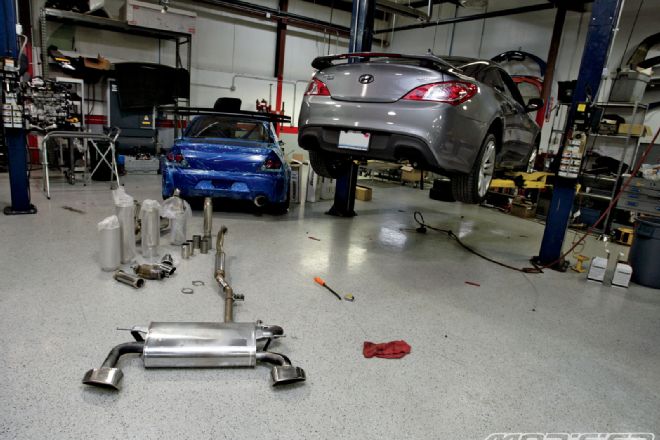If you read the May issue of Modified, then you'll probably remember the test drive we did of Hyundai's new and affordable rear-wheel-drive sports coupe, the Genesis Coupe. Test driver and senior editor Andy Hope felt that the 210-bhp, 2-liter turbo version would be the hot ticket with some mods, but in stock form enjoyed the V-6 version more for its ability to hang the tail end out, thanks to its 306-bhp and easily disabled traction control. Question is, how receptive will the 2.0T Genesis Coupe be to some aftermarket monkey business designed to push horsepower up into rear-tire-burning territory? To answer that question, I turned to AMS Performance's special projects technician Ivan Phipps (whose 9-second, street-legal S14 was featured back in July '07), who recently picked up a Nordschleife Gray 2.0T Track coupe in order to evaluate it and develop a line of AMS go-fast goodies for it.
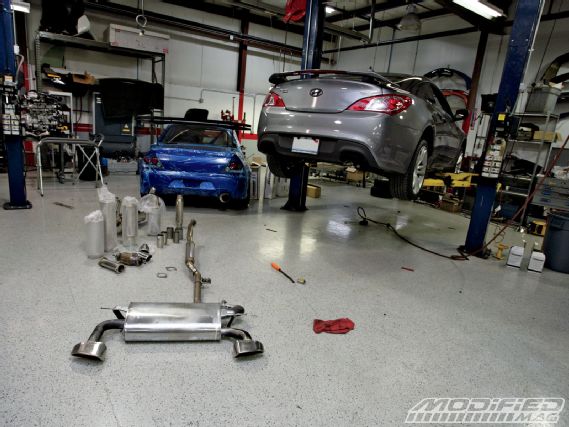 |
Ivan Phipps and the AMS R&D team have been working overtime to evaluate the coupe and have already prototyped a number of bolt-on power-adders, including a full turbo-back exhaust system.
|
Ivan Phipps and the AMS R&D team have been working overtime to evaluate the coupe and have already prototyped a number of bolt-on power-adders, including a full turbo-back exhaust system.
If you're unfamiliar with AMS Performance, you've probably been in a five-year coma because this shop has become one of the most widely respected tuning shops and performance parts manufacturers in the country. Known best for its DSM and EVO tuning expertise and its dominant EVO time attack and drag machines, in recent years AMS has expanded its product line to include an increasingly diverse group of machines like the Subaru Impreza and R35 Nissan GT-R as well as some Euro machines like the BMW 335i and Porsche 996 and 997 Turbo. Soon, the Hyundai Genesis Coupe will be added to that list, once the engineering team at AMS puts the final touches on the prototyped parts in development for this platform.
But before they could start the prototyping process, Ivan and the AMS crew had to spend some time evaluating the OEM components in order to determine where their special go-fast voodoo is needed most. As you may know, the 2-liter turbo engine in the Genesis Coupe is a GEMA World Engine collaboratively designed by Mitsubishi, Chrysler and Hyundai for use in their respective vehicle lineups. So the 2.0T Genesis Coupe's basic engine design is very closely related to the EVO X's engine, though there are significant differences-including cylinder head and manifold designs. But given the underlying DNA of the World Engine in the Hyundai, there's good reason to believe the Gen Coupe's 2-liter mill is capable of pumping out some serious horsepower with a little love from the aftermarket.
Once Ivan took delivery of his Korean turbo coupe, he and the AMS team began their evaluation with a dyno session to baseline it for power, boost level, air/fuel ratio as well as fuel pressure, manifold air temperature, knock sensor readings and spark plug condition. With this information, as well as a detailed visual inspection and measuring session, the R&D team is able to determine which stock components will need to be upgraded first in the search for more power and which stock components can be left in place a little longer. According to Ivan, "We feel that the exhaust, intercooler and intercooler piping are going to be the biggest restrictions. All three of these items are just tiny from the factory."
 |
2010 Hyundai Genesis Coupe Turbo - Affordable RWD Fun - Tech Talk
|
2010 Hyundai Genesis Coupe Turbo - Affordable RWD Fun - Tech Talk
According to AMS' measurements, the factory exhaust has a 2.375-inch (60mm) outer diameter and is crushed down to 1.75-inch for about 8 inches in length to clear an underbody brace. The mid-pipe attaches to a secondary catalytic converter, and because this cat is behind the O2 sensor, deleting it shouldn't throw a check-engine light. The mid-pipe also has a bullet-style resonator, which likely has an inner diameter smaller than the rest of the exhaust system. So clearly there's some room for improvement. "We did some careful measuring and feel that a 3-inch exhaust system will fit very well and still be routed cleanly. We are exploring several upgrade paths including a side-entrance, dual-end outlet muffler like we are using for our BMW 335i exhaust, a dual muffler straight shot setup and possibly a tunable exhaust like we are producing for the EVO X."
Ivan and the AMS team also measured the factory intercooler, which is just 4.75 inches tall, 3.5 inches thick and 20 inches wide. Given these measurements, clearly this core has a small cross-section, frontal area and volume, which will limit cooling ability and increase pressure drop. According to Ivan, "I don't think it would be out of line to say a better designed core with a larger cross-section, volume and frontal area will increase performance, especially considering the size of the factory core." However, finding the space to mount a bigger intercooler is going to be tricky. "The factory intercooler is sandwiched between the core support and the radiator fan shroud and is just below the radiator. We could get a larger and better-designed core in that spot, but it would be limited. After measuring, we found that we could fit a core that has 44 percent more cross-section, 44 percent more volume and 26 percent more frontal area. Not a bad increase and one that should prove beneficial with the stock turbo or a mildly upgraded turbo. If we moved the intercooler forward and kept the crash beam in place, we could increase volume, cross-section and frontal area by approximately 70 percent. If we remove the crash beam, an intercooler with 160 percent more volume, cross-section and frontal area is possible, which would be ideal for just about any turbo kit you could put on the Gen Coupe."
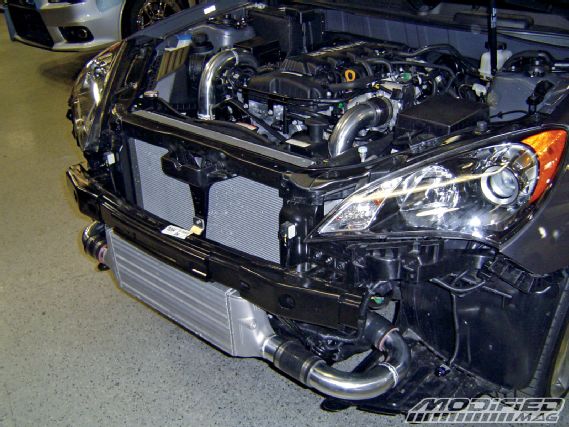 |
By moving the intercooler in front of the rad support, AMS has been able to test a larger and more efficient core on its Gen Coupe.
|
By moving the intercooler in front of the rad support, AMS has been able to test a larger and more efficient core on its Gen Coupe.
This all sounds very promising, but moving the intercooler forward so a larger one can be fitted presents a number of challenges. According to Ivan, "The power steering loop (cooler) will probably need to be relocated, as may the horns and two air temp sensors. In addition, the factory intercooler end tanks are support members for the radiator to the core support, so removing the factory intercooler would require brackets be made to keep the radiator in place. The last thing that would need to be addressed is the fan shroud. With the factory intercooler removed, there would be about a 5-inch opening at the bottom of the shroud, which would hurt the efficiency of the fan. To address this, some sort of block-off plate or air guide would be needed."
With solutions to these challenges well underway, the next obvious step in the pursuit of more power is to turn up the boost. AMS has looked closely at the factory fuel system, ECU and turbo system in order to assess just how easily and reliably boost pressure can be increased. Having already turned up the boost on their Gen Coupe with a manual boost controller, they quickly discovered that the factory ECU limits boost, so AMS' team of ECU geeks are now hard at work investigating various solutions to this problem. With respect to the fuel system, flow testing showed that the stock fuel pump is on par with the EVO 9 pump, so it will not require upgrading until the turbocharger is modified or upsized. Larger injectors will also be needed when upgrading the turbo, and it would also appear that the factory blow-off valve won't tolerate much of an increase in boost pressure, so AMS has already designed a block-off plate for where the factory BOV lives, allowing for a higher performance BOV to be used instead.
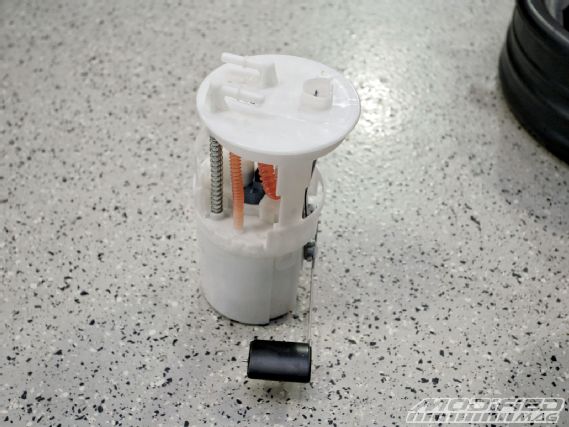 |
The 2.0T fuel pump is a nice unit that flows on par with the EVO 9 pump, meaning it won't need an upgrade until a bigger turbo is installed.
|
The 2.0T fuel pump is a nice unit that flows on par with the EVO 9 pump, meaning it won't need an upgrade until a bigger turbo is installed.
As part of its ongoing evaluation of the Genesis Coupe, AMS will soon be testing upgraded turbochargers that use the factory exhaust manifold so that the underhood look of the car remains stock, but they've also got a rapid-prototyped tubular manifold ready for test fitting as part of a full turbo kit upgrade package that will inevitably follow. Given how busy AMS is with parts development for other new platforms like the GT-R, as well as maintaining stock on their existing lineup of parts and building their radical EVO X time attack beast, it may be a while before a full Genesis Coupe turbo kit is available. Then again, if Ivan and the crew keep working after-hours to develop parts for his track coupe like they have to prototype the downpipe and mid-pipe, secondary cat delete, cat-back exhaust, intake silencer delete, front-mount intercooler and piping kit, and manual boost controller they've already dyno tested, then maybe you 2.0T coupe owners should at least start saving up for the first round of AMS bolt-on power-adders. And knowing Ivan's love of big horsepower (remember, this is a guy with a 9-second S14 street car), I think it's safe to say that AMS' product line for the Genesis turbo coupe will eventually go well beyond the usual bolt-ons
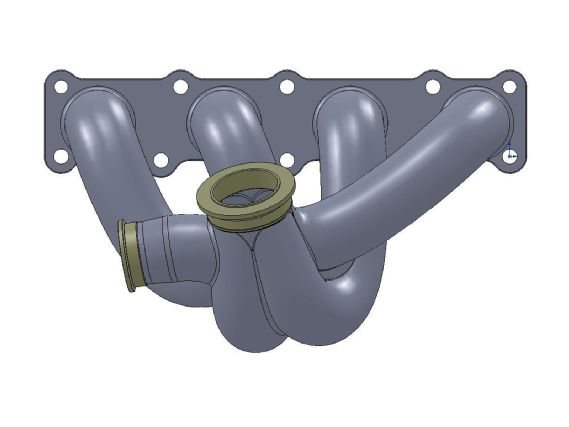 |
The go-fast engineers at AMS have already CAD-designed and 3-D rapid-prototyped a tubular exhaust manifold for test fitting, a process that suggests a full AMS turbo kit is not that far off.
|
The go-fast engineers at AMS have already CAD-designed and 3-D rapid-prototyped a tubular exhaust manifold for test fitting, a process that suggests a full AMS turbo kit is not that far off.
For updates on AMS' progress with their Hyundai Genesis 2.0T coupe, point your web browser at www.amsperformance.com and follow along with their blog.
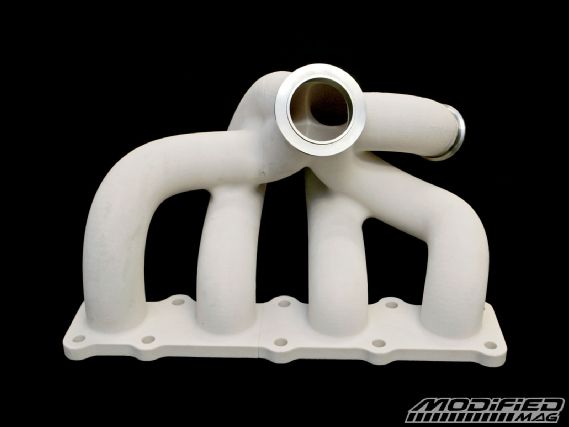 |
2010 Hyundai Genesis Coupe Turbo - Affordable RWD Fun - Tech Talk
|
2010 Hyundai Genesis Coupe Turbo - Affordable RWD Fun - Tech Talk

